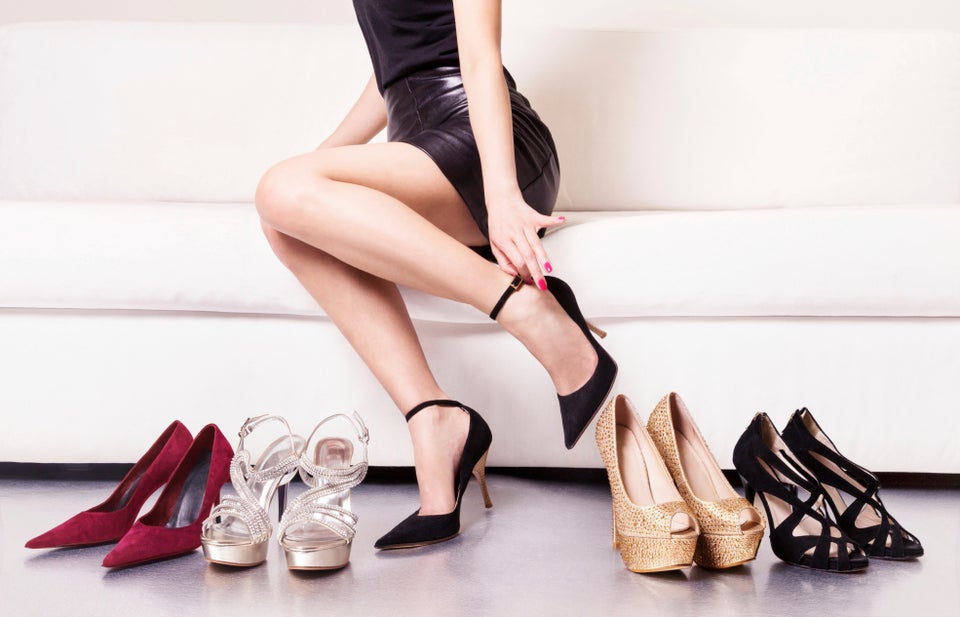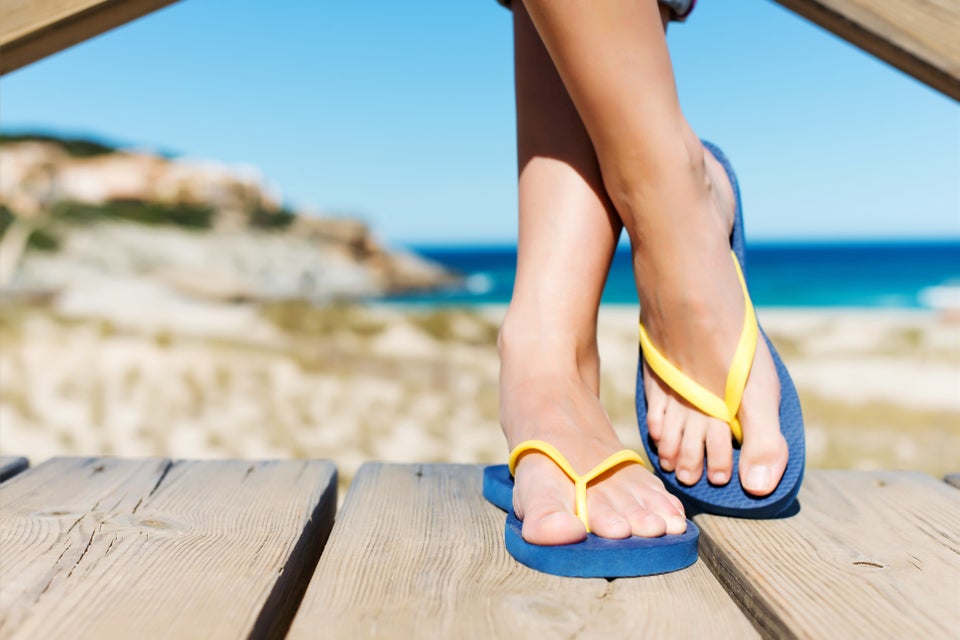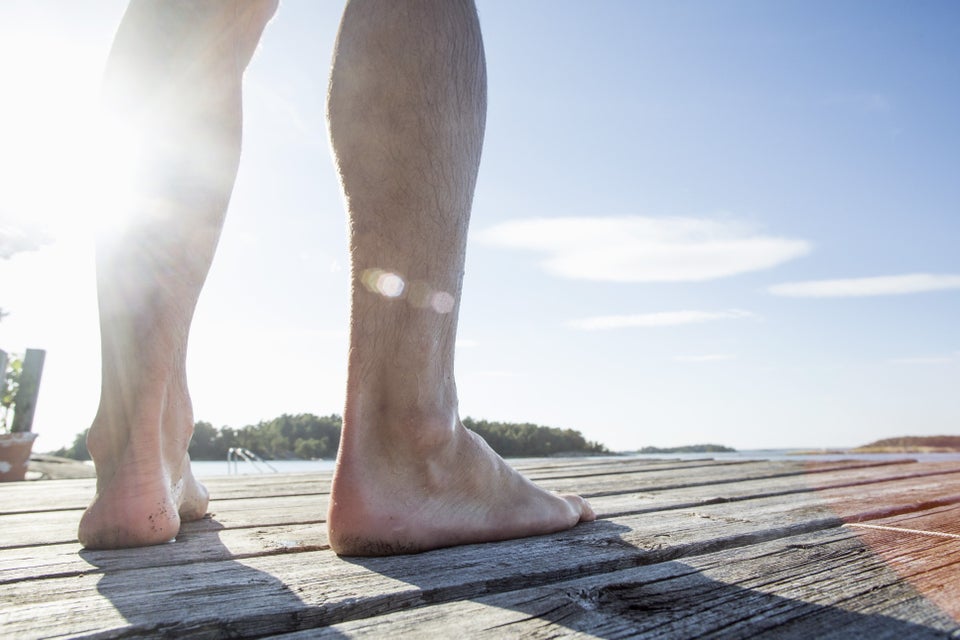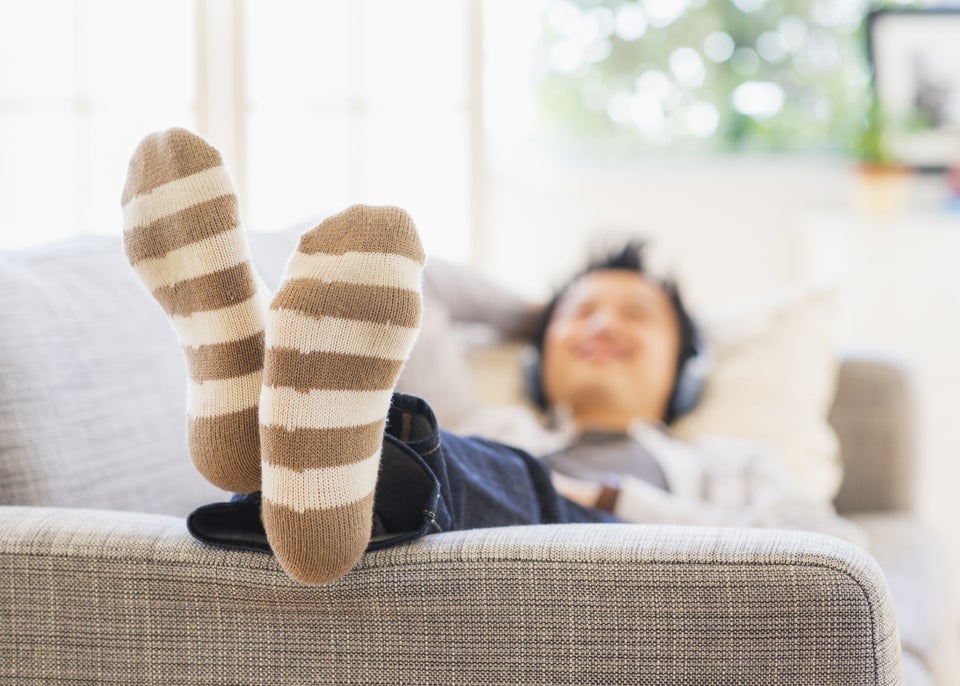Foot massages, special socks, custom shoe inserts -- those who suffer from foot pain have likely tried it all. But what you might not realize, athletic trainer Carolyn Peters says, is that the source of your pain may not even be in your feet.
"Common foot pain is actually increased by calf tightness," Peters says in the above #OWNSHOW video. "So a lot of people don't realize they've got some tender spots in their calf."
By applying pressure to trigger points in your calves, Peters says many people will feel relief in their feet. The first step is to check for tenderness by pressing on the length of the calf muscle. If you find a trigger point, there are a few different objects you can use to apply pressure: a foam roller, PVC pipe, or lacrosse ball will all do the trick, Peters says.
To start, sit on the ground and extend your leg. Place your calf on whatever device you chose to use and roll the object over the muscle until you find the tender spot. Then, flex and point your ankle 10 times, Peters instructs. Repeat this process on any other tender spots you find.
The reason this technique works, Peters says, is because it focuses on the connective tissues that surround the calf muscle. "It's kind of like a cobweb in our body -- you pull one edge and it all gets tight," she says.
By applying pressure and moving the joint through a range of motion, you help the affected connective tissue to elongate and loosen up, Peters says.
As a bonus, this technique can also relieve charley horse pain. "This is going to help because you're bringing blood flow to the area because you're actively moving the joint, you've got some pressure on the area, you're helping with the connective tissue and you're getting a little stretch while you're doing that," she says.
If you try this technique at home, Peters says to monitor your pain level. If your level of pain goes up instead of down, stop and consult with your doctor.
More: A simple stretch everyone who wears high heels should try.
Related
Before You Go

A new pair of sandals often comes at the steep price of painful blisters. The sores form from chafing that happens when a shoe rubs up against the skin until it balloons out, filling with fluid to cushion and protect the deeper layers of skin underneath, explains Jackie Sutera, a New York City podiatrist.
The first step for prevention, says Jane Andersen, a podiatrist in Chapel Hill, North Carolina and a spokesperson for the American Podiatric Medical Association, is to buy shoes that are comfortable when you buy them and don't need to be "broken in." Look for soft fabrics or leathers, and then take them for a test drive at home for an hour or so to make sure you stay pain-free before you wear them outside. You can also try lining any painful spots with moleskin to prevent the friction that ultimately causes blisters.
But sometimes, even seemingly comfy shoes can cause problems. "I've purchased perfectly good pairs of shoes that have given me blisters," Andersen says. If you do end up in pain, clean the blister with regular hand soap and try to leave it intact. But if the pain is unbearable, use an alcohol-sterilized needle to poke a tiny hole in the side of the blister and drain the fluid out, leaving all the skin intact. Then apply some antibiotic ointment and cover with a band-aid. (Don't try this at home if you're diabetic, though, Andersen cautions.)

Over-wearing this summertime staple can cause stress fractures, heel pain and tendonitis, and can exacerbate hammertoes. "These are not shoes that we should be wearing from 8 in the morning to 8 at night," Sutera says. "That's not really what these shoes are made for."
That said, they're hard to resist. And there are ways you can make flip flops a safer footwear choice.
"Not all flip flops are created equally," Sutera says. Look for a pair with a thicker sole with arch support -- and the more straps the better, as that can reduce the stress placed on the toes from gripping the flip flop so it doesn't fly off your foot. You shouldn't be able to bend the flip flop (or any shoe, for that matter), in half -- that's your first clue that it won't provide enough support. Reserve the ultra-thin ones for the locker room or pool.

Walking barefoot might be one of the great joys of summer, but it can also put you at an increased risk of contracting viruses like warts, fungus such as athlete's foot, or bacteria that can cause a skin infection, Andersen explains. These things tend to thrive in warm, moist environments, like a public pool.
Going shoeless also raises the risk of picking up foreign bodies, like stepping on glass or splinters.
Even walking around barefoot at home can be problematic, Andersen says, because the foot is left unsupported. If your house has a no-shoes rule, consider throwing on a pair of supportive slippers or indoor flip flops.

For some people, hot temps mean sweaty feet, and all that moisture can increase the risk picking up an infection. Andersen suggests wearing socks that wick excess moisture away, and changing out of damp socks as soon as possible. If you can't shower, at least rinse your feet off. "Keep a nice, cool environment for your feet," she says.
One natural trick? Brew regular black tea, let it cool and tuck your feet in for 30 minutes. Andersen says the tannins in the tea can decrease sweat production.

For many, polished toenails are a summertime necessity -- but serious health risks might be lurking in the pedicure chair.
"Pedicures can be a source for real problems," Andersen says. Everything from the tools to the relaxing whirlpool soak can transmit nail fungus, wart viruses and sometimes serious bacterial infections.
To stay safe, consider bringing your own tool set, Sutera says, especially the foot file, and clean your tools back home with a betadine solution. She also tells her patients to avoid the "Wednesday special," or a great deal that brings dozens more customers -- and germs -- through the salon. If possible, schedule your appointment at the beginning of the day, when technicians should be less tired and the tools and basins a little bit cleaner.
And don't shave or wax your legs for at least 24 hours before your appointment -- hair removal can cause microscopic cuts, increasing susceptibility to infection.

One study from the University of Miami and the "Today" show found that a single pair of flip flops can harbor a whopping 18,000 bacteria, including the dangerous superbug Staphylococcus aureus.
Walking the streets in open shoes can mean kicking up all sorts of debris, including human vomit, feces, bird droppings and a whole host of other unappetizing things, Phillip Tierno, director of clinical microbiology and immunology at the NYU Langone Medical Center, told The Huffington Post. Then you take your shoes off and touch, say, your face. "It's a repository for everything you brought in from the outside and [you] don't give it a second thought," he said.
A few simple precautions can keep you safe: Tierno recommends removing your shoes before entering the house and avoiding wall-to-wall carpeting when possible, as it can harbor germs. Slip on a pair of slippers at the end of the day and wash your hands thoroughly -- between 25 and 30 seconds -- after you remove your shoes.

Wearing open-backed shoes can spread the fat pad of the heel, causing the skin to crack, says Andersen. If you have any deep cracks where you can see dried blood, treat the heel with an antibiotic oil and cover with a band aid.
But if you just have run-of-the-mill dry summer heels, Sutera suggests treating them with an exfoliating moisturizer every day and run a pumice stone over them once or twice a week in the shower -- but only in one direction, as going back and forth can actually make the split skin worse.
Dry, cracked heels can also be a sign of a fungus, psoriasis, thyroid issues and diabetes, Sutera says. If you're concerned, visit a podiatrist or dermatologist to get the all clear.

